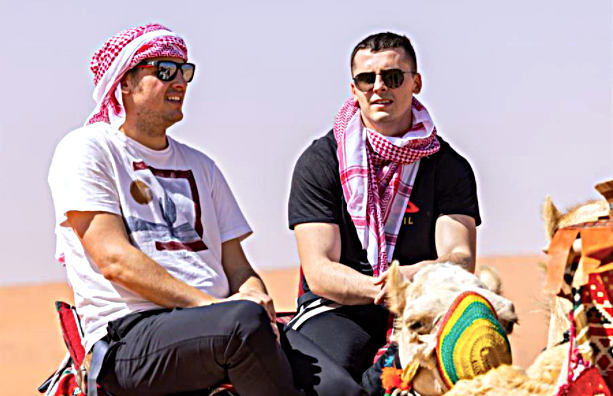JEDDAH: The northwestern Saudi city of Jubbah has the most famous rock art inscription site in the country, and is the fourth place in the Kingdom to be inscribed on the UNESCO List of World Heritage Sites.
This ancient location, with its spectacular dunes and sandy landscape, is being offered to adventurous travelers as a gateway to the desert.
The King Salman Royal Natural Reserve, which is the largest in the country and the fourth largest wild reserve in the world, is offering people inside and outside Saudi Arabia an immersive desert experience amid the 130,700 square kilometer space.
Rakayb Jubbah, which started on Feb. 24 and continues until March 19, allows visitors aged 18 and above to get a taste of an authentic Bedouin lifestyle.
The program has four trips, with each trip lasting three days.
The reserve tweeted earlier this month: “The desert adventure that people have experienced for so long to survive and look for water resources has now become a journey leading to recreation moments in the desert.”
Ebtisam Azzam, a Saudi radio and TV presenter, was one of the 20 people on the first trip.
HIGHLIGHTS
• This ancient location, with its spectacular dunes and sandy landscape, is being offered to adventurous travelers as a gateway to the desert.
• The King Salman Royal Natural Reserve is offering people inside and outside Saudi Arabia an immersive desert experience amid the 130,700-square-kilometer space.
“Rakayb Jubbah is an adventure, a unique and strange trip,” she told Arab News. “It is a mix of entertainment and harmony inside the King Salman Reserve in the Nafud desert. In the past, people used to go for long camel rides to search for water resources, trade, and travel. Now, we are experiencing the same trip but for leisure, a place where you find seclusion and some mental clarity.”
The adventure includes trekking on camel back for 20 kilometers over six hours, a simulation of camel caravans from the past, meaning participants need to have medium-level fitness.
“Camels, that’s another story. It is one of the greatest creatures and the tangible relation between the camel and its owner, and how the camel understands a sound or a sign that his owner made, is all spectacular,” Azzam said. “Just looking at the camel can make you figure out something about yourself. It takes time to make the camel familiar with a new person and I think I'm on the way.”
Safari trips and adventures require travelers to be well equipped and dressed in an outfit that suits the nature and atmosphere of the place they are going to.
But Rakayb Jubbah took place four days after Founding Day, and Azzam was still celebrating the new Saudi national holiday by wearing regional attire during the camel ride to represent the southern Asir region.
“I brought the southern (style of) dress with me, specifically the black Asiri dress, the scarf, the yellow head tie, and some silver accessories. I took a lot of beautiful pictures on the camel to document the moment and the beauty of the place.”
The trip aims to introduce activities that will help visitors understand more about the reserve’s natural and tourism elements.
It wants to activate ecotourism, as people will learn about Hail chants, folklore dances, and other aspects of the area's heritage.
Visitors will also be exposed to ways of coexisting with desert environments and learning about rare plants in the reserve such as talha, ghada, and arfaj, in addition to dealing with camels.
The area has a history spanning thousands of years and is full of remnants from the past, including more than 4,000 Thamudic drawings and inscriptions.
Abdulaziz Al-Damkh, a Saudi traveler who has been to over 45 countries, was also on the trip. “The trip exceeded my expectations in terms of organizing, the side events, safety measures, and the amazing team spirit,” he told Arab News.
Al-Damkh said that, although he was a huge adventurer, it was his first time experiencing a six-hour camel ride.
“I am Saudi and I was born in Saudi and camels are part of my culture, but this was my very first time to experience what a long ride feels like. Such trips should have been happening a long time ago.
“The first two hours of the ride were very tiring, as some of the participants have not been into such experiences, but it went well eventually.”
People on the first trip included visitors from Spain, the US and Tunisia, and the trip was organized by Pangaea, a Saudi firm offering outdoor activities.
The Kingdom has embraced leisure tourism in recent years to attract visitors from around the world.
“Such events provide you with a truly authentic desert experience. It contributes in promoting our Saudi culture, and it sheds light on Vision 2030 and its goals in diversifying tourism in the Kingdom,” Al-Damkh added.
Each trip has 20 participants and costs SR2,000 ($533) per person. The trip includes camping, stargazing, and traditional Saudi food.
The reserve aims to resettle natural life, develop vegetation, and preserve the historical and cultural heritage of the area, which is part of Saudi Arabia’s environmental identity.
















